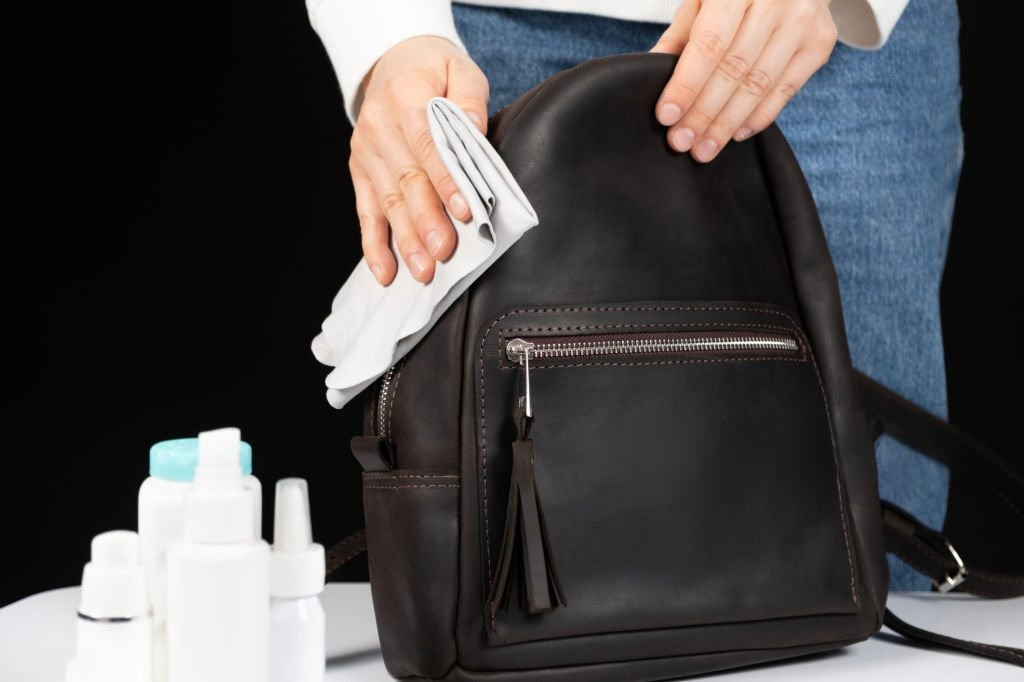No products in the cart.
Say Goodbye to Mold: Expert Tips for Leather Bag Storage
Is your beloved leather bag sitting in the closet, trapped under a musty, stubborn mould smell that just won’t go away? It’s frustrating to see your favourite accessory, once full of life and style, now marred by unsightly spots and a lingering odour that makes you hesitant to even take it out. The good news is that this problem isn’t hopeless. With the right Leather care and simple steps, you can breathe new life into your leather bag and finally say goodbye to mould for good, but where do you begin? Here is a complete solution to your problem.
Causes and Risks of Mold on Leather
Leather’s porous texture absorbs moisture, making it vulnerable to mould and mildew when exposed to damp, humid conditions. Mould thrives in environments where warmth and moisture combine with poor ventilation conditions, often found in closets, basements, or storage boxes without airflow.
Why Mold Develops on Leather Bags
| Cause | Explanation |
| High Humidity | Moist air creates the perfect environment for mould growth. |
| Poor Ventilation | Stagnant air traps moisture and spores on the leather surface. |
| Improper Storage | Using plastic covers or storing bags damply promotes mould growth. |
| Residual Dirt or Oils | Organic residues feed mould spores, encouraging their spread. |
Health Risks of Mold on Leather
Mold is not just an aesthetic issue; it can impact your health. According to the Centers for Disease Control and Prevention (CDC), exposure to mould spores can trigger allergic reactions, asthma attacks, skin irritations, and respiratory infections, especially in sensitive individuals. Handling mouldy leather without precautions may spread spores into the air, potentially exacerbating these effects.
How to Get Mold Off Leather
Removing mould from leather requires a delicate balance between effective cleaning and protecting the leather’s integrity. Harsh chemicals or excessive water can cause the leather to dry out, crack, or discolour.
Using Vinegar and Alcohol for Mold Removal
White vinegar and rubbing alcohol are natural disinfectants widely recommended for mould removal. Vinegar’s acidity kills many mould species, while alcohol helps to disinfect surfaces. However, both can dry out leather, so they should be diluted and followed by conditioning.
Step-by-Step Cleaning Process for Removing Mold from Leather Bags
Successfully removing mould from leather requires patience and care. Each step is crucial to ensure that the mould is eliminated without damaging your valuable leather bag. Follow this detailed process carefully:
1. Test the Cleaning Solution
Before you begin cleaning the entire bag, always perform a patch test. Choose a small, inconspicuous area, such as the inside seam or the underside of a flap. Apply a small amount of your chosen cleaning solution, whether it is diluted white vinegar or a rubbing alcohol mixture, and wait for 10 to 15 minutes.
Observe the tested spot for any changes in colour, texture, or softness. If you notice discolouration, fading, or stiffness, do not proceed with that solution on the rest of the bag. Instead, try a milder approach or consult a professional leather cleaner. Testing helps prevent irreversible damage and preserves your bag’s original appearance.
2. Remove Loose Mold
Mold spores can be airborne and spread easily, so it is important to handle this step outdoors or in a well-ventilated area to avoid contaminating indoor spaces.
Using a soft-bristled brush, such as a clean paintbrush or a shoe brush, gently sweep away loose mould from the leather surface. Alternatively, a dry microfiber cloth works well to lift spores without pressing them deeper into the leather’s pores. Be careful not to scrub aggressively as this can scratch or damage delicate leather surfaces. This step helps remove the bulk of the mould before applying any cleaning solution.
3. Apply the Cleaning Solution
Mix equal parts white vinegar and water or dilute rubbing alcohol with water in a 50/50 ratio. Both vinegar and alcohol are natural antifungal agents that effectively kill mould spores, but their acidity and drying effects mean you must use them carefully.
Lightly dampen a soft, lint-free cloth with the cleaning solution. Wring out any excess liquid to avoid saturating the leather. Gently wipe the mouldy areas in circular motions, covering all affected spots. Avoid soaking the leather as excessive moisture can worsen the problem or cause warping.
If stubborn mould patches persist, repeat the application, but always allow the leather to dry between treatments. Avoid harsh scrubbing to protect the leather’s finish.

4. Drying
Proper drying is critical to prevent mould from returning and to preserve leather quality. After cleaning, place your leather bag in a shaded, well-ventilated area. Air circulation helps evaporate moisture gently without heat damage.
Avoid direct sunlight, radiators, hair dryers, or any artificial heat source. Excessive heat can dry out the leather’s natural oils, leading to cracks, stiffness, and fading. Depending on humidity levels, drying may take several hours to a full day. Ensure the bag feels completely dry before moving on.
5. Conditioning
Once your leather bag is fully dry, it’s essential to restore its moisture balance and suppleness. Mould removal and cleaning solutions tend to strip away the natural oils in leather, which are vital for flexibility and appearance.
Apply a high-quality leather conditioner specifically designed for your type of leather. Use a soft cloth to apply the conditioner evenly, rubbing it in gently. Follow the manufacturer’s instructions regarding the amount and drying time.
Conditioning nourishes the leather, prevents cracking, and forms a protective barrier against future mould growth and moisture damage. Regular conditioning every few months also keeps your leather bag looking vibrant and feeling soft.
Effective Products for Mold Removal
| Product | Purpose | Why Use It? |
| Lexol Leather Cleaner | Gently cleans dirt and mould without damage | Preserves leather’s texture and color |
| Lexol Leather Conditioner | Restores moisture and suppleness | Prevents drying and cracking |
| Dehumidifiers | Removes excess moisture from storage environments | Prevents mold by reducing humidity |
Preventing Mold on Leather: Expert Storage Tips
Prevention is the most reliable way to protect your leather bags. Adopting the right storage and maintenance habits will keep mould at bay and extend the life of your accessories.
Storage Tips to Prevent Mold
- Choose the Right Location: Store bags in cool, dry, and well-ventilated spaces. Avoid basements, garages, or any high-humidity areas.
- Use Breathable Covers: Instead of plastic bags, use cotton or linen dust bags to allow airflow while protecting from dust.
- Keep Bags Dry: Never store leather bags while damp. Let them air dry thoroughly before putting them away.
Ventilation is Key
Good airflow prevents moisture buildup, the main trigger for mould growth. Make sure your storage areas have proper ventilation. Occasionally, open closets or storage boxes to circulate air.
Regular Maintenance
Regularly clean and condition your leather bags. Dirt, sweat, and oils attract mould spores and can damage leather if not removed.
Additional Preventive Measures
| Preventive Action | How It Helps |
| Clean Bags Regularly | Removes mold spores and dirt buildup |
| Store and Keep Bags Dry | Eliminates moisture, a mold’s breeding ground |
| Use Leather Conditioner | Creates a moisture barrier |
| Place Silica Gel Packets Inside | Absorbs excess humidity |
| Use Anti-Mold Patches | Inhibits mold growth chemically |
| Use a Dehumidifier in the Storage Area | Controls overall humidity |
| Avoid Using Bags in Wet Environments | Prevents moisture exposure |
| Inspect Bags Frequently | Catches early mould signs before damage |
Final Thoughts
Mould on leather bags is an unfortunate but common issue that can be effectively managed with the right knowledge and care. Understanding the causes and risks empowers you to act quickly to remove mould safely and prevent its return. Regular cleaning, conditioning, proper storage, and moisture control are your best defences against mould damage.
By following these expert tips, you will preserve the elegance and durability of your leather bags for years to come. For more in-depth leather care advice, explore the wealth of guides and resources available at Leather Mingle, your trusted source for expert leather maintenance.
Frequently Asked Questions
Can Moldy Leather Be Saved?
Yes. Early intervention with proper cleaning and conditioning often restores mouldy leather bags. Severe infestations may require professional treatment.
Is Mold on Leather Toxic?
Mold can release allergens and irritants that are harmful to health, particularly for sensitive individuals. Handle mouldy leather carefully and clean it promptly.
Does Vinegar Clean Mold Off Leather?
Vinegar is effective at killing many mould spores, but it must be diluted and used cautiously to prevent leather damage.
How Often Should I Condition Leather to Prevent Mold?
Conditioning every 3 to 6 months helps maintain the leather’s moisture balance and resilience against mold.
Can Mold Return After Cleaning?
Yes, if storage conditions remain damp and poorly ventilated. Prevention and proper storage are crucial to keeping mould away.










Add comment